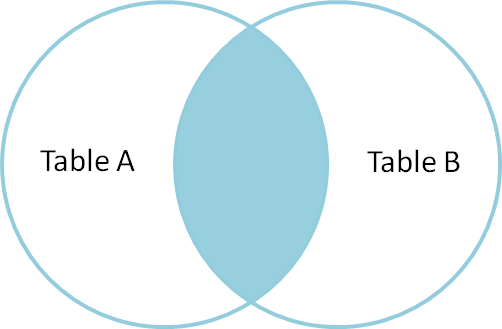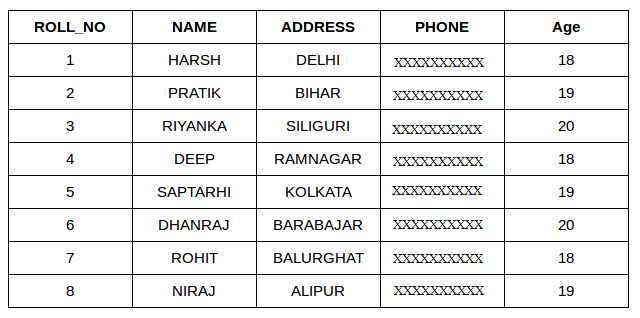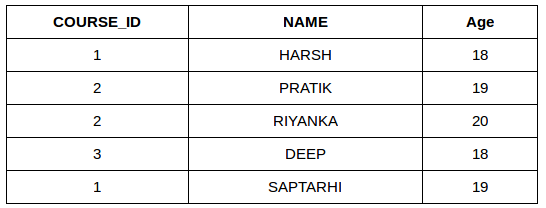
(SQL Example for Citizen Data Scientist & Business Analyst)
SQL | Join (Inner, Left, Right and Full Joins)
A SQL Join statement is used to combine data or rows from two or more tables based on a common field between them. Different types of Joins are:
- INNER JOIN
- LEFT JOIN
- RIGHT JOIN
- FULL JOIN
Consider the two tables below:
Student
StudentCourse
The simplest Join is INNER JOIN.
- INNER JOIN: The INNER JOIN keyword selects all rows from both the tables as long as the condition satisfies. This keyword will create the result-set by combining all rows from both the tables where the condition satisfies i.e value of the common field will be same.
Syntax:SELECT table1.column1,table1.column2,table2.column1,.... FROM table1 INNER JOIN table2 ON table1.matching_column = table2.matching_column; table1: First table. table2: Second table matching_column: Column common to both the tables.
Note: We can also write JOIN instead of INNER JOIN. JOIN is same as INNER JOIN.

Example Queries(INNER JOIN)
- LEFT JOIN: This join returns all the rows of the table on the left side of the join and matching rows for the table on the right side of join. The rows for which there is no matching row on right side, the result-set will contain null. LEFT JOIN is also known as LEFT OUTER JOIN.Syntax:
SELECT table1.column1,table1.column2,table2.column1,.... FROM table1 LEFT JOIN table2 ON table1.matching_column = table2.matching_column; table1: First table. table2: Second table matching_column: Column common to both the tables.
Note: We can also use LEFT OUTER JOIN instead of LEFT JOIN, both are same.

Example Queries(LEFT JOIN):
SELECT Student.NAME,StudentCourse.COURSE_ID FROM Student LEFT JOIN StudentCourse ON StudentCourse.ROLL_NO = Student.ROLL_NO;
- RIGHT JOIN: RIGHT JOIN is similar to LEFT JOIN. This join returns all the rows of the table on the right side of the join and matching rows for the table on the left side of join. The rows for which there is no matching row on left side, the result-set will contain null. RIGHT JOIN is also known as RIGHT OUTER JOIN.Syntax:
SELECT table1.column1,table1.column2,table2.column1,.... FROM table1 RIGHT JOIN table2 ON table1.matching_column = table2.matching_column; table1: First table. table2: Second table matching_column: Column common to both the tables.
Note: We can also use RIGHT OUTER JOIN instead of RIGHT JOIN, both are same.

Example Queries(RIGHT JOIN):
SELECT Student.NAME,StudentCourse.COURSE_ID FROM Student RIGHT JOIN StudentCourse ON StudentCourse.ROLL_NO = Student.ROLL_NO;
- FULL JOIN: FULL JOIN creates the result-set by combining result of both LEFT JOIN and RIGHT JOIN. The result-set will contain all the rows from both the tables. The rows for which there is no matching, the result-set will contain NULL values.Syntax:
SELECT table1.column1,table1.column2,table2.column1,.... FROM table1 FULL JOIN table2 ON table1.matching_column = table2.matching_column; table1: First table. table2: Second table matching_column: Column common to both the tables.

Example Queries(FULL JOIN):
SELECT Student.NAME,StudentCourse.COURSE_ID FROM Student FULL JOIN StudentCourse ON StudentCourse.ROLL_NO = Student.ROLL_NO;
Learn to Code SQL Example – SQL | Join (Inner, Left, Right and Full Joins)
Disclaimer: The information and code presented within this recipe/tutorial is only for educational and coaching purposes for beginners and developers. Anyone can practice and apply the recipe/tutorial presented here, but the reader is taking full responsibility for his/her actions. The author (content curator) of this recipe (code / program) has made every effort to ensure the accuracy of the information was correct at time of publication. The author (content curator) does not assume and hereby disclaims any liability to any party for any loss, damage, or disruption caused by errors or omissions, whether such errors or omissions result from accident, negligence, or any other cause. The information presented here could also be found in public knowledge domains.
Learn by Coding: v-Tutorials on Applied Machine Learning and Data Science for Beginners
Latest end-to-end Learn by Coding Projects (Jupyter Notebooks) in Python and R:
All Notebooks in One Bundle: Data Science Recipes and Examples in Python & R.
End-to-End Python Machine Learning Recipes & Examples.
End-to-End R Machine Learning Recipes & Examples.
Applied Statistics with R for Beginners and Business Professionals
Data Science and Machine Learning Projects in Python: Tabular Data Analytics
Data Science and Machine Learning Projects in R: Tabular Data Analytics
Python Machine Learning & Data Science Recipes: Learn by Coding
R Machine Learning & Data Science Recipes: Learn by Coding
Comparing Different Machine Learning Algorithms in Python for Classification (FREE)
There are 2000+ End-to-End Python & R Notebooks are available to build Professional Portfolio as a Data Scientist and/or Machine Learning Specialist. All Notebooks are only $29.95. We would like to request you to have a look at the website for FREE the end-to-end notebooks, and then decide whether you would like to purchase or not.





